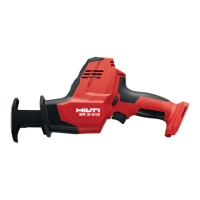English 5
▶ Wear protective gloves also when changing the accessory tool. Touching the accessory tool presents a
risk of injury (cuts or burns).
▶ The user and persons in the vicinity must wear suitable protective goggles, a hard hat, ear defenders,
protective gloves and light respiratory protection while the power tool is in use.
▶ Before starting work, check the hazard class of the dust that will be produced when working. Use
an industrial vacuum cleaner with an officially approved protection class in compliance with the locally
applicable dust protection regulations. Dust from materials such as lead-based paint, certain types of
wood and concrete/masonry/stone containing quartz, minerals or metal can be harmful to health.
▶ Make sure that the workplace is well ventilated and, if necessary, wear a respirator appropriate for
the type of dust generated. Contact with or inhalation of the dust can cause allergic reactions and/or
respiratory or other diseases among operators or bystanders. Only specialists are permitted to handle
material containing asbestos.
▶ When you use the Hilti retaining strap, make sure it is not damaged or frayed.
▶ Take breaks between working and do relaxation and finger exercises to improve the blood circulation in
your fingers.
▶ Do not look directly into the light source (LEDs) of the power tool and do not aim the beam at other
persons’ faces. Risk of dazzling or eye damage.
▶ Flying fragments can injure the body and eyes. Wear your personal protective equipment and always
wear protective glasses and protective gloves.
▶ If work involves break-through, always secure the area on the side opposite where the work is carried
out.
Electrical safety
▶ Hold the power tool by the insulated gripping surfaces when performing work in which the accessory
tool might come into contact with concealed wiring. If the accessory tool comes into contact with a live
wire, metal parts of the power tool can also become live, resulting in an electric shock.
2.5 Battery use and care
▶ Observe the special regulations and instructions applicable to the transport, storage and use of Li-ion
batteries.
▶ Do not expose batteries to high temperatures, direct sunlight or fire.
▶ Do not disassemble, crush or incinerate batteries and do not subject them to temperatures over 80 °C.
▶ Do not use or charge batteries that have suffered mechanical impact, have been dropped from a height
or show signs of damage. In this case, always contact your Hilti Service.
▶ If the battery is too hot to touch it may be defective. In this case, place the product in a non-flammable
location, well away from flammable materials, where it can be kept under observation and allowed to
cool down. In this case, always contact your Hilti Service.
Printed: 07.01.2019 | Doc-Nr: PUB / 5470139 / 000 / 00

